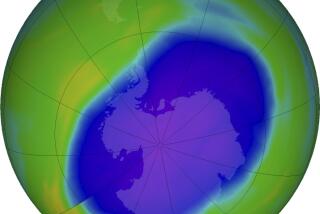Ozone Hole Closing Late This Year Because of Antarctic Wind Patterns
- Share via
WASHINGTON — With spring arriving in the Southern Hemisphere, the Antarctic ozone hole is closing for the season, National Oceanic and Atmospheric Administration scientists reported Friday.
The hole is filling in late this year, said Samuel B. Oltmans of the agency’s Climate Monitoring and Diagnostics Laboratory in Boulder, Colo.
The delay was caused by a circle of persistent winds surrounding the Antarctic continent, which prevented air there from mixing with the atmosphere from other regions, officials said.
The agency reported that ozone levels over Antarctica climbed to 220 dobson units on Dec. 6 and to 270 units by Dec. 10, according to measurements made by instruments carried aloft by balloons. Ozone over the South Pole reached a low of 130 dobson units in early October, only marginally above the record low measured in 1987.
That thinning of the layer is sometimes referred to as a hole, although it amounts to somewhat less than half of the normal ozone level of over 300 units in that part of the world.
Ozone is vital in the upper atmosphere, where it blocks some of the hazardous ultraviolet radiation from the sun. A reduction in ozone could lead to damage to crops and animal life and to an increase in skin cancer among humans, some scientists warn.
The dobson unit is a measurement of ozone made by comparing how much of each of two wavelengths of sunlight is absorbed by the air. That ratio changes depending on the concentration of ozone.
More to Read
Sign up for Essential California
The most important California stories and recommendations in your inbox every morning.
You may occasionally receive promotional content from the Los Angeles Times.












